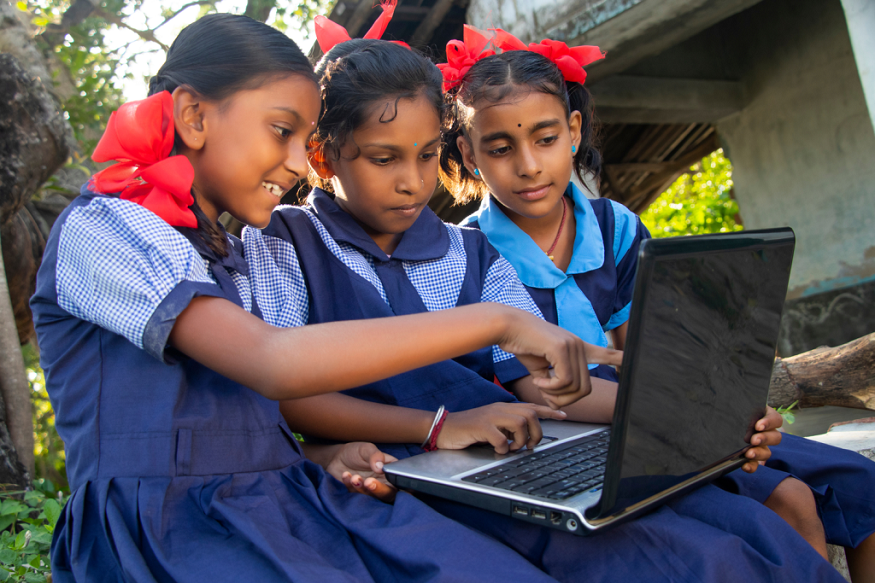The Digital Revolution in Girl Child Education
The integration of technology in girl child education has emerged as one of the most powerful forces for educational equality in the 21st century. As we navigate through 2025, digital education for girls is not just an option—it’s become a necessity for creating inclusive, accessible, and personalized learning experiences that address the unique challenges girls face in pursuing education.
The transformation has been remarkable. From remote villages in India to urban centers in Africa, technology is breaking down traditional barriers that have historically limited girls’ access to quality education. The digital divide gender gap, once a significant obstacle, is gradually closing as innovative solutions emerge to ensure equal access to educational technology.
Breaking Down Barriers: How Digital Learning Transforms Access
Digital education for girls addresses multiple barriers simultaneously. In regions where cultural norms restrict girls’ mobility, online learning platforms provide safe spaces for education within the home environment. Where teacher shortages affect rural schools, digital platforms deliver quality instruction from expert educators regardless of geographical constraints.
The impact has been quantifiable and transformative. According to recent studies, online learning platforms girls utilize show 40% higher completion rates compared to traditional classroom settings in areas with significant gender disparities. This success stems from the flexibility and personalization that technology in girl child education offers, allowing girls to learn at their own pace while managing family responsibilities.
AI in Girl Education: Personalized Learning at Scale
AI in girl education represents the cutting edge of educational technology, creating personalized learning experiences that adapt to individual needs and learning styles. Machine learning algorithms analyze learning patterns, identify knowledge gaps, and provide customized content that ensures no girl falls behind.
Leading AI-powered platforms have demonstrated remarkable results. Adaptive learning systems adjust difficulty levels in real-time, ensuring girls remain challenged but not overwhelmed. These platforms have shown 35% improvement in learning outcomes for female students compared to one-size-fits-all approaches.
The technology also addresses unconscious bias in educational content. AI systems can identify and eliminate gender-biased language or examples in educational materials, ensuring that digital education for girls provides truly inclusive learning experiences that build confidence and encourage participation in traditionally male-dominated subjects.
EdTech for Female Students: Specialized Platforms and Solutions
EdTech for female students has evolved beyond generic educational apps to create targeted solutions addressing specific challenges girls face. These platforms incorporate features like flexible scheduling, mobile-first design for areas with limited internet infrastructure, and culturally sensitive content that resonates with diverse female experiences.
Specialized platforms have emerged in STEM education, recognizing that girls often face additional barriers in science, technology, engineering, and mathematics. These online learning platforms girls use gamification, peer support networks, and female role models to create engaging environments that challenge stereotypes and build confidence in technical subjects.
The success metrics are compelling: girls using specialized EdTech platforms show 50% higher engagement rates in STEM subjects and are 30% more likely to pursue advanced courses in these fields. This represents a fundamental shift in how technology in girl child education can address systemic inequalities.
Digital Literacy Girls: Building Foundation Skills
Digital literacy girls programs have become essential components of modern education, recognizing that technology skills are no longer optional but fundamental for future success. These initiatives go beyond basic computer skills to include critical thinking about digital information, online safety, and digital creation skills.
Comprehensive digital literacy programs show remarkable outcomes. Girls who complete these programs demonstrate 60% higher digital confidence scores and are significantly more likely to pursue technology-related careers. The programs also address online safety concerns that disproportionately affect girls, teaching them to navigate digital spaces safely and confidently.
The integration of digital literacy into digital education for girls creates a multiplier effect—girls not only consume educational content but become creators and innovators, contributing to the digital economy and closing the technology gender gap.
Mobile Learning: Reaching Girls Everywhere
Mobile technology has revolutionized digital education for girls, particularly in developing regions where smartphones are more accessible than computers or reliable internet. Mobile learning platforms designed for girls incorporate offline functionality, low-bandwidth requirements, and culturally appropriate content delivery methods.
The statistics are striking: mobile learning initiatives targeting girls show 70% higher reach rates compared to computer-based programs. These platforms have been particularly effective in rural areas, where girls can access educational content during commutes or in spaces where traditional learning might not be possible.
Online learning platforms girls access through mobile devices offer unprecedented flexibility. Girls can learn during breaks from household chores, late in the evening, or early in the morning—adapting education to their unique schedules and circumstances rather than forcing them to adapt to rigid educational structures.
Virtual Classrooms: Creating Safe Learning Spaces
Virtual classrooms have emerged as powerful tools for technology in girl child education, creating safe, inclusive environments where girls can participate actively without fear of judgment or harassment. These digital spaces level the playing field, allowing girls to engage with content and participate in discussions without the social pressures that might inhibit their involvement in traditional classrooms.
Research indicates that girls in virtual classrooms participate 45% more frequently in discussions and demonstrate higher academic achievement compared to mixed-gender traditional classrooms. The anonymity and safety of digital spaces allow girls to express ideas freely and take intellectual risks that might be socially discouraged in physical settings.
Addressing the Digital Divide Gender Gap
The digital divide gender represents both a challenge and an opportunity in educational technology. While girls have historically had less access to technology, targeted interventions have shown remarkable success in closing this gap and even creating advantages for female learners.
Innovative financing models, including micro-loans for educational technology and community-shared devices, have made digital education for girls more accessible. Government and NGO partnerships have established technology centers in underserved communities, ensuring that economic barriers don’t prevent girls from accessing digital learning opportunities.
The results have been transformative. In regions where targeted interventions have addressed the digital divide gender, girls’ educational outcomes have improved dramatically, with some areas reporting gender parity in educational achievement for the first time in their history.
Success Stories: Global Impact of Digital Learning
Online education girls programs worldwide have generated inspiring success stories that demonstrate the transformative power of technology. In Bangladesh, a mobile learning initiative increased girls’ secondary school completion rates by 25%. In Nigeria, an AI-powered tutoring system helped girls in rural areas achieve mathematics scores comparable to their urban counterparts.
These success stories share common elements: community support, culturally appropriate content, and recognition of girls’ unique challenges and strengths. They demonstrate that technology in girl child education is most effective when it’s designed with girls’ specific needs and contexts in mind.
The Role of Artificial Intelligence in Personalization
AI in girl education extends beyond adaptive learning to include predictive analytics that identify girls at risk of dropping out and automated interventions that provide timely support. These systems analyze attendance patterns, learning performance, and engagement metrics to provide early warning systems for educational challenges.
AI-powered career counseling systems help girls explore educational and career pathways that align with their interests and abilities, challenging traditional gender stereotypes about appropriate fields of study. These systems have shown particular success in encouraging girls to pursue STEM careers, with 40% of users expressing increased interest in technology-related fields.
Overcoming Infrastructure Challenges
Digital education for girls has driven innovation in addressing infrastructure limitations. Satellite-based internet delivery, solar-powered devices, and mesh networking solutions have extended educational technology to the most remote regions.
These innovations have been particularly beneficial for girls, who often face greater mobility restrictions. By bringing technology to girls rather than requiring them to travel to technology centers, these solutions have dramatically expanded access to quality education.
Building Digital Confidence and Leadership
EdTech for female students increasingly focuses on building not just academic skills but digital confidence and leadership abilities. Platforms include features like peer mentoring, project-based learning, and opportunities for girls to create and share their own educational content.
These approaches have shown remarkable results in building girls’ confidence in technology. Participants in comprehensive digital education programs are 55% more likely to see themselves as technology leaders and 40% more likely to pursue advanced studies in technical fields.
Future Trends and Innovations
The future of technology in girl child education promises even more transformative innovations. Virtual and augmented reality are creating immersive learning experiences that make abstract concepts tangible. Blockchain technology is enabling secure, portable academic credentials that girls can carry across borders and institutions.
Emerging technologies like quantum computing and advanced AI promise to further personalize education, creating learning experiences that adapt not just to girls’ academic needs but to their emotional and social development as well.
Measuring Impact and Ensuring Sustainability
The success of digital education for girls requires robust measurement and evaluation systems. Advanced analytics track not just completion rates but engagement quality, skill development, and long-term outcomes like career advancement and continued learning.
Sustainability models are evolving to ensure that technological innovations in girls’ education can be maintained and scaled. Public-private partnerships, community ownership models, and integration with existing educational systems are creating foundations for long-term success.
Challenges and Solutions
Despite remarkable progress, online learning platforms girls still face challenges including cybersecurity concerns, digital wellness issues, and the need for human connection in learning. Innovative solutions are emerging to address these challenges while maintaining the benefits of digital education.
Hybrid models combining digital and face-to-face learning are showing particular promise, offering the flexibility and accessibility of digital education for girls while maintaining the social connections and mentorship that are crucial for girls’ educational success.
The Global Movement Forward
The transformation of technology in girl child education represents more than technological advancement—it’s a global movement toward educational equity and female empowerment. As these technologies continue to evolve and expand, they’re creating unprecedented opportunities for girls to access, engage with, and excel in education.
The digital divide gender is closing, but the work is far from complete. Continued innovation, investment, and commitment to girls’ education through technology will determine whether these promising developments translate into lasting change for girls worldwide.
Conclusion: A Digital Future for All Girls
Digital education for girls has evolved from an experimental concept to a proven strategy for educational transformation. The evidence is clear: when girls have access to quality educational technology designed for their needs, they not only succeed—they excel.
The future holds even greater promise as AI in girl education becomes more sophisticated, online learning platforms girls become more accessible, and the digital divide gender continues to narrow. Technology is not just changing how girls learn—it’s changing what’s possible for girls’ futures.
As we look ahead, the continued development of EdTech for female students will play a crucial role in achieving global educational equity. The digital revolution in girls’ education is not just transforming individual lives—it’s creating the foundation for a more equitable and prosperous future for all.




